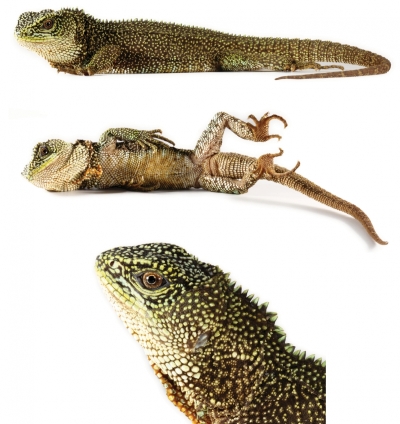New Dwarf Dragons Known as Wood Lizards Discovered in Andes Cloud Forests

Three dwarf dragons were reportedly found recently in the cloud forests of South America.
Also known as wood lizards, the dwarf dragons are a diverse set of reptiles that showcase different shades such as neon green or bloody red. Some have scarlet eyes, while others wear armor-like spikes that give them an uncanny resemblance to their mythological namesakes.
The three newly discovered creatures from a biodiversity hotspot in the Andean cloud forests of Peru and Ecuador raise the number of the species to 15 as scientists submitted research on them to the journal Zookeys.
"Wood lizards are fairly large and conspicuous, so it's interesting that roughly half of the currently recognized species have been discovered in the last 10 years," said Kevin de Queiroz, Torres-Carvajal's supervisor at the Smithsonian's National Museum of Natural History. "This illustrates how much we still have to learn about South American reptiles."
The first of the dwarf dragons found is the Enyalioides altotambo, or the Alto Tambo wood lizard, named after the tiny village in northwestern Ecuador where it was collected. The males look similar to a baby iguana while the females have a chameleon-like appearance with a flatter and broader face and a tubular body. Their scales are smooth and equally sized compared to other dwarf dragons with spikes and disks.
Another dwarf dragon, the rough-scaled wood lizard Enyalioides anisolepis, was found in the forested slopes of the Amazonian Andes in southern Ecuador and northern Peru. It follows the look of the traditional mythical dragon given its stud-like scales that project outward covering its body and limbs. Its color ranges from black to bright green to brown to burnt orange, Smithsonian said.
The last of the three, the Enyalioides sophiarothschildae or Rothschild's wood lizard, has a slender black-and-brown body with bright green spikes. It has "immaculate white labials and chin" or bright scales around its mouth and neck like a white-chinned cat.
Torres-Carvajal and his colleagues have discovered seven new species of dwarf dragons in the past seven years.
 Christians don't have to affirm transgenderism, but they can’t express that view at work: tribunal
Christians don't have to affirm transgenderism, but they can’t express that view at work: tribunal Archaeology discovery: Medieval Christian prayer beads found on Holy Island
Archaeology discovery: Medieval Christian prayer beads found on Holy Island Presbyterian Church in America votes to leave National Association of Evangelicals
Presbyterian Church in America votes to leave National Association of Evangelicals Over 50 killed in 'vile and satanic' attack at Nigerian church on Pentecost Sunday
Over 50 killed in 'vile and satanic' attack at Nigerian church on Pentecost Sunday Ukrainian Orthodox Church severs ties with Moscow over Patriarch Kirill's support for Putin's war
Ukrainian Orthodox Church severs ties with Moscow over Patriarch Kirill's support for Putin's war Islamic State kills 20 Nigerian Christians as revenge for US airstrike
Islamic State kills 20 Nigerian Christians as revenge for US airstrike Man who served 33 years in prison for murder leads inmates to Christ
Man who served 33 years in prison for murder leads inmates to Christ


 Nigerian student beaten to death, body burned over ‘blasphemous’ WhatsApp message
Nigerian student beaten to death, body burned over ‘blasphemous’ WhatsApp message 'A new low': World reacts after Hong Kong arrests 90-year-old Cardinal Joseph Zen
'A new low': World reacts after Hong Kong arrests 90-year-old Cardinal Joseph Zen Iran sentences Christian man to 10 years in prison for hosting house church worship gathering
Iran sentences Christian man to 10 years in prison for hosting house church worship gathering French Guyana: Pastor shot dead, church set on fire after meeting delegation of Evangelicals
French Guyana: Pastor shot dead, church set on fire after meeting delegation of Evangelicals ‘Talking Jesus’ report finds only 6% of UK adults identify as practicing Christians
‘Talking Jesus’ report finds only 6% of UK adults identify as practicing Christians Mission Eurasia ministry center blown up in Ukraine, hundreds of Bibles destroyed: 'God will provide'
Mission Eurasia ministry center blown up in Ukraine, hundreds of Bibles destroyed: 'God will provide' Church holds service for first time after ISIS desecrated it 8 years ago
Church holds service for first time after ISIS desecrated it 8 years ago Burger King apologizes for 'offensive campaign' using Jesus' words at the Last Supper
Burger King apologizes for 'offensive campaign' using Jesus' words at the Last Supper Uganda: Muslims abduct teacher, burn him inside mosque for praying in Christ’s name
Uganda: Muslims abduct teacher, burn him inside mosque for praying in Christ’s name